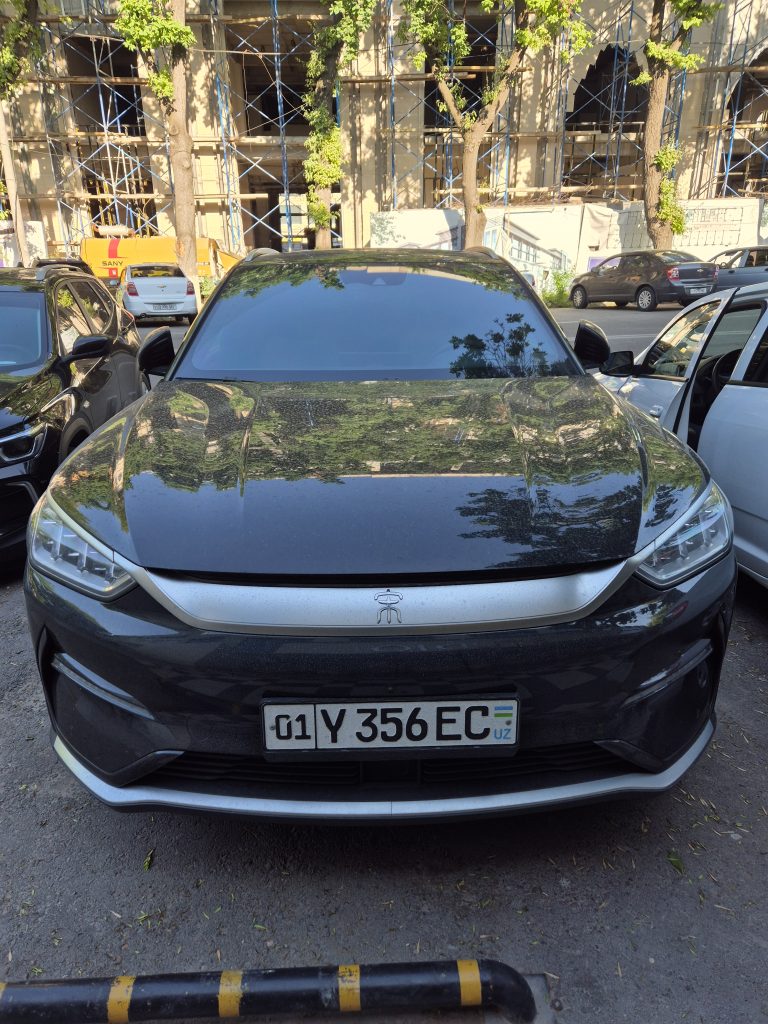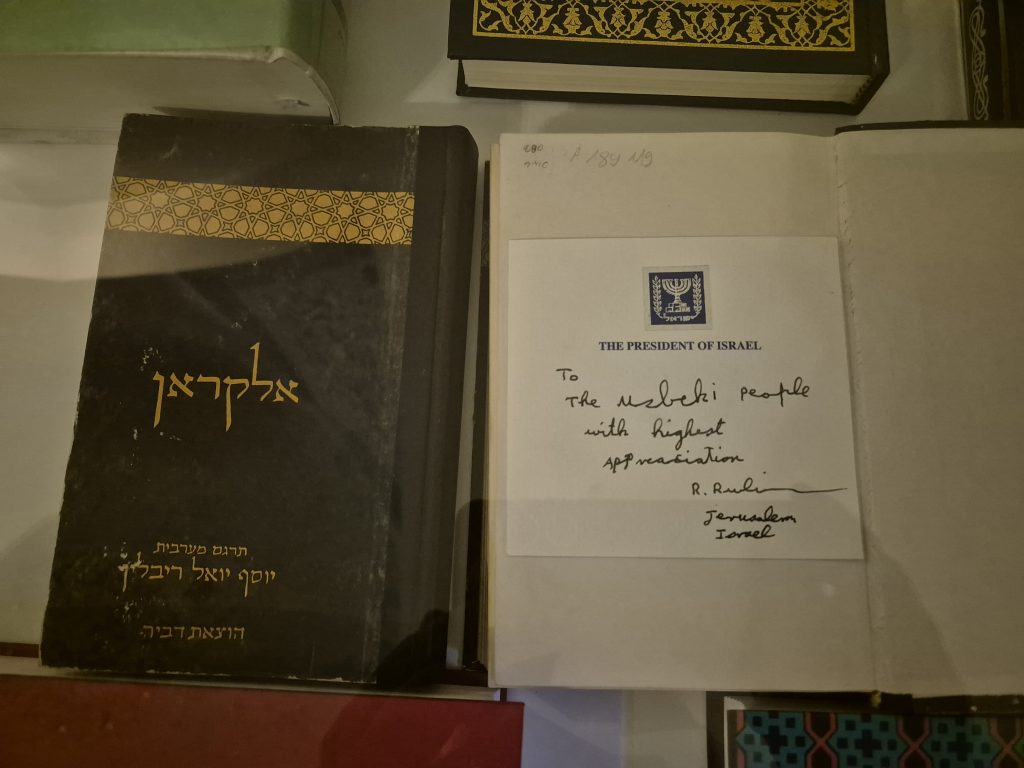Today we set out to discover Tashkent with Inom. Inom has a black Chevrolet. This is unusual we discovered, as 90% of all cars here are white, and 80% of all cars are Chevrolets. So the most frequent cars here are all white Chevrolets.

This seems quite peculiar at first until you learn that Chevrolet has some big factories here in UZ and those are locally produced cars. In 2008, General Motors and the government of Uzbekistan joined forces to form GM Uzbekistan and mass-produce Chevrolet-branded cars. The government held a 75% ownership stake, while GM had 25%. To import any car from outside UZ costs a hefty 30% import tax. So everyone but the ultra rich buys local cars. Other cars you might see are mainly asian, with Chinese cars taking over that segment more and more. Here and there you might see electric cars and chargers as well.

We were pleasantly surprised to drive through a clean, vibrant city that had a blend of interesting aspects to it. Not at all boring. You could clearly see the influence of multiple centuries in the architecture and art styles. Old timuresque style buildings and bazaars, traditional islamic medrassas that were not destroyed by the Russians, a Soviet style TV tower and very modern buildings springing up at every corner of the new part of town.

We began our journey by visiting Khast Imom Islamic religious center which is a fairly new construction but next door an even bigger one is being built as we visited – funded by Saudi Arabia. Khast Imom consisted of a mosque, medrassa (quoran school) and the Moyie Mubarek Library Museum grouped around a large courtyard.

The library houses the oldes known Quoran book. Written on deer skin it lies in a climatized glass coffin surrounded by hundreds of Quoran copies of all shapes, sizes and languages. The smallest book we saw was barely 2 cm tall. There was also a hebrew version of the holy Quoran.

On we went to the Museum of Applied Arts showcasing the various arts and craft skills of Uzbekistan. Silk weaving, textile printig, wood carving, tile making and other ceramics of a variety of ages were displayed. The ability and know-how to produce silk and paper was for the longest time a secret kept by the Chinese. But as the Chinese empire was in dire need of horses to defend their territory, the turks (standing for all turk nations) were able to swap horses for the secret of silk and paper making. Since then Fergana Valley in Uzbekistan is known not only for it’s great horses but also for silk making.
We decided it was time for lunch and Inom drove us to the Central Asian Plov Center Besh Qozon. There in a large building all you can get is various types of Plov, the national dish of Uzbekistan. Their Plov is made in four meter wide cauldrons over wood fires. Huge chunks of meat and fat are being cooked for hours, carots, onions and spices added and the rice on top. It takes several hours for it to cook, so they had 8 or 9 of different large Plov cooking stations going at the same time.


We sat down inside and ordered: Beef Plov with a slice of horse meat for Chris, a large tomato and onion salad for Esther both served with Non, the traditional Uzbek round loaf of bread.

While Chris’ Plov was supposed to be rice and beef, it still tasted of mutton thanks to the mutton fat that was used to make the Plov even richer in taste. Esther just tried one bite, Chris picked at the beef but really could not eat the oily, mutton infused rice. We much preferred the ultra light chicken variant of Plov that Borat had cooked for us, but maybe we have had enough Plov for this vacation already.

Next stop was the Amir Timur statue right in front of the iconic Hotel Uzbekistan, the quintessential soviet style hotel. Amir Timur is probably as famous and important for the local history as Djingis Khan was.

From a young age, Timur showed dedication to the traditions of the nomadic steppe people, excelling in horse riding and archery. After being wounded in battle, he was left paralyzed in his right arm and leg, earning him the nickname “Timur the Lame.” He became governor of Shahrisabz at 25 through a strategic marriage, swiftly establishing his rule through conquests. Timur’s empire, known as the Timurid Empire, extended across Central Asia, Afghanistan, Pakistan, parts of India, Iran, Iraq, the Caucasus, Syria, and parts of Turkey.

Timur not only brought war spoils to Samarkand (our next top) but also artisans and craftsmen from various lands. Consequently, other cities in his empire were adorned with architectural masterpieces that define Uzbekistan until today. He died during a campaign in Kazakhstan, on his way conquering parts of China, with his legacy living on in the architectural marvels of Samarkand, where he was buried. His military prowess relied on mobility, surprise, and strategic patience, which enabled him to expand his empire significantly.

From there we walked through the „boulevard“ a pedestrian zone with little antique stalls like a flea market and small street food vendors until we came to one of Tashkents Metro stations.

We boarded our train at Mustaqillik Maydoni Station, changed in Alisher Navor and ended up in Kosmonavtlar, the most famous station also called ‘the space station’.

Tashkent Metro is really something to experience. It is like traveling through a museum by train.

Leaving the metro, we walked back towards our car passing the Alsiher Navoi Opera & Ballet Theatre, an elegant building with an empty water fountain in front in form of a budding Cotton plant. As Esther had noticed before, none of the citys fountains we passed were working. As if someone heard that she liked fountains, all of a sudden the fountain in front of the theatre sprang to life. It was a pretty sight with water coming out of the cotton bud.

Our last stop for that day was the TV Tower, a 375 meter high soviet style tower with an observatory deck and a rotating restaurant (like we have in Munich, but somewhat smaller and thus moving at double the speed, taking 30 minutes for one 365 degree circle).

We went up to the observatory deck which offered grandiose views all over the city. We were amazed at how green Tashkent looked from above. Lots of trees and a small canal running through it.

As we felt a bit peckish, we tried our luck in the restaurant two floors up from the deck. All tables were booked , but we were allowed to sit at the bar and have a nice glass of wine and a delicious appetizer: crispy aubergine cubes with cream cheese. Yummy!

We chatted with Inom and the bar tender, sipping our wine (and yes, there is local wine that is drinkable) and watching a very nice sun setting over Tashkent. No more food for us, we were happy to just return to the hotel, pack for the next day as we need to leave early for Samarkand, which usually is a four hour ride by car or 2.15 h with the fast Afrosiyob Train.




